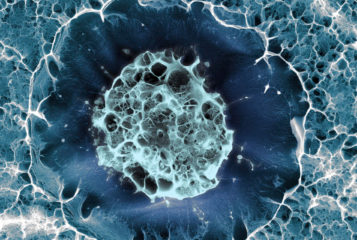For the first time adult skin cells have been reprogrammed into an embryonic-like state using proteins instead of genes. This feat represents a major step towards overcoming safety concerns associated with many other methods of cell reprogramming. This research was led by members of the Scripps Research Institute in La Jolla, California, US, and published in the online version of the journal Cell Stem Cell.
Embryonic stem cells (ES cells) are important because they are 'pluripotent' - they have the ability to become any of the body's cell types, such as those in the heart or nervous system, potentially leading to new therapies for human diseases ranging from Type 1 diabetes to Parkinson's disease. However, their use is considered ethically questionable because embryos must be destroyed in order to harvest the cells.
In the last few years alternative approaches have been developed. Mature human cells can be reprogrammed into an embryonic state by introducing four foreign genes. Since the genes are transported into the cells with the aid of a virus the approach carries risks. The inserted genes may cause other unwanted changed in the target cell and the virus can cause cancer. Rather than directly inserting the four genes into the cell, the new method involves inserting four proteins associated with those genes instead. 'We engineered these four proteins so that they can penetrate the cell and return it to a primitive state', said Sheng Ding of Scripps Research Institute, who led the research. 'We are very excited about this breakthrough in generating embryonic-like cells from fibroblasts without using any genetic material,' he continued, adding: 'Scientists have been dreaming about this for years.'
Ding and his team found that the pIPS cells (protein-induced pluripotent stem cells) derived from fibroblasts (cells that give rise to connective tissue) are indistinguishable from ES cells in both their molecular and functional features. This includes differentiation into many different types of cell, such as pancreatic cells, neurons, or beating cardiac muscle cells. The authors of the research (undertaken on mice) now hope to replicate their results in humans, but the approach would have to be considerably improved before it would be suitable for clinical use because it is slow and inefficient.
However, steps are being taken to make the technique safer. For example, one team has successfully reprogrammed mouse cells using a less harmful adenovirus (like those that cause the common cold) as a transport vehicle. Another has managed to remove the inserted genes and viruses once they have served their purpose. Nevertheless Ding believes the ultimate goal is to avoid any kind of biological material altogether and reprogram cells using small drug-like molecules alone.
Sources and References
-
Major Breakthrough In Generating Safer, Therapeutic Stem Cells From Adult Cells
-
Chemist cites advance in stem cell field
-
Induced stem cell advance
-
Embryonic stem cells without embryos





Leave a Reply
You must be logged in to post a comment.